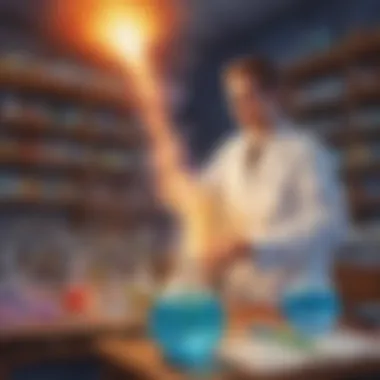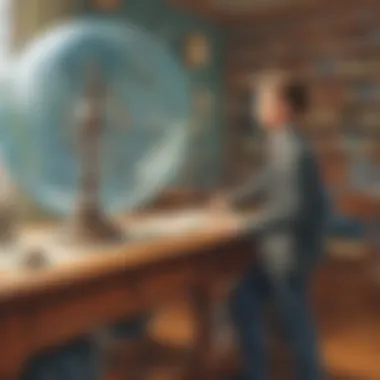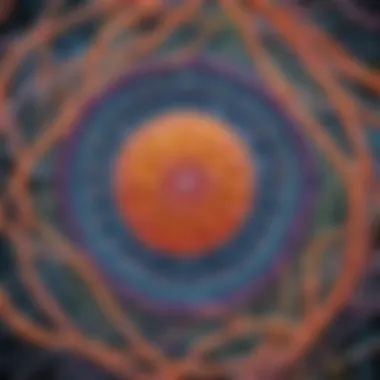Engaging Junior High Science Experiments to Spark Young Minds' Curiosity


Science Fun Facts
Did you know that the first artificial sweetener, saccharin, was discovered accidentally in 1879 by Constantine Fahlberg? Scientists believe he forgot to wash his hands after performing an experiment which led to the sweet taste. These quirky incidents often shape the course of scientific discoveries, such as the accidental invention of the microwave or the origins of penicillin.
Within the realm of science, there exist some remarkable records that never fail to astonish. For instance, did you know that the world's largest snowflake was recorded in Fort Keogh, Montana, in 1887? This snowflake measured an astonishing 15 inches in diameter! Engage young minds with these amazing science records to spark curiosity and highlight the wonders of the natural world.
Science often poses intriguing questions that challenge our understanding of the universe. Consider this: Why do we see the sky as blue during the day, but it appears dark at night? Encourage junior scientists to ponder such thought-provoking questions as a gateway to deeper exploration and critical thinking skills.
Discover the Wonders of Science
Embark on a journey to unravel the mysteries of science by exploring various scientific concepts that define our world. From the principles of electricity to the intricacies of genetics, students aged 11-14 can delve into the fascinating realms of physics, chemistry, and biology through engaging experiments and activities.
Enhance the learning experience with educational videos and animations that visually depict complex scientific phenomena in an easily understandable manner. Supplement classroom teachings with interactive learning tools that make abstract concepts tangible and relatable, fostering a profound appreciation for the natural world.
Uncover the practical applications of science in everyday life, showcasing how scientific knowledge drives technological advancements and shapes our world. By highlighting real-life examples, students can grasp the relevance of scientific principles and envision themselves as future innovators and problem-solvers.
Science Quiz Time
Challenge young minds with interactive quizzes that test their knowledge of scientific principles and phenomena. From multiple-choice questions that assess comprehension to brain teasers that stimulate critical thinking, encourage active participation in learning through gamification and fun puzzle-solving activities.
Engage students in a playful yet educational manner, boosting retention and understanding through interactive quizzes and thought-provoking challenges. Transform traditional learning into an exciting adventure of discovery and enlightenment that transcends the confines of the classroom.
Science Experiment Showcase
Immerse students in the world of science with a showcase of fun and engaging experiments that foster hands-on learning and exploration. From exciting chemistry demonstrations to captivating physics projects, provide step-by-step instructions that guide students through each experiment with clarity and precision.
Equip aspiring scientists with a detailed materials list to ensure they have everything they need for a successful experiment. Prioritize safety by including vital tips and precautions to guarantee a secure and enjoyable learning experience, promoting a culture of responsibility and mindfulness in scientific inquiry.
Introduction to Junior High Science Experiments
In the realm of education, the introduction to junior high science experiments holds a pivotal position, laying the foundation for explorative learning among young minds. These experiments present a gateway to the intricate world of scientific principles and phenomena, offering students aged 11-14 an immersive experience like no other. By engaging in hands-on activities across various scientific disciplines, students not only enhance their cognitive abilities but also develop a profound curiosity towards the workings of the natural world. The significance of junior high science experiments cannot be overstated; they serve as the catalysts for igniting a passion for science and inquiry at a crucial stage in a student's academic journey.


Importance of Hands-On Science Experiments
The Role of Practical Learning in Science Education
Practical learning in science education stands as a cornerstone in shaping young minds into adept scientific thinkers. By immersing students in real-world experiments and observations, practical learning bridges the gap between theoretical knowledge and practical application, enriching their understanding of scientific concepts. The hands-on approach fosters a deeper connection with the subject matter, allowing students to experience the challenges and rewards of scientific inquiry firsthand. This method not only enhances retention and comprehension but also cultivates essential skills such as problem-solving, observation, and data analysis. Practical learning in science education is a dynamic and effective tool in nurturing the next generation of scientists and innovators.
Enhancing Critical Thinking Skills Through Experiments
One of the primary objectives of junior high science experiments is to enhance critical thinking skills among students. Through the process of designing experiments, making observations, and drawing conclusions, students are encouraged to think analytically and logically. This active engagement stimulates their cognitive abilities, encouraging them to question, analyze, and evaluate information critically. By confronting challenges and uncertainties in their experiments, students develop resilience and adaptability, essential traits for future academic and professional success. Engaging in hands-on experiments not only sharpens their critical thinking skills but also instills a lifelong appreciation for the scientific method and evidence-based reasoning.
Engaging Middle School Students in Science
Tailoring Experiments to Capture Young Minds
Tailoring experiments to capture the imaginations of middle school students is an art that requires creativity and insight. By creating experiments that resonate with the interests and curiosities of young minds, educators can captivate their attention and foster a love for science. Incorporating relatable examples, interactive elements, and visually stimulating materials can make the scientific concepts more accessible and engaging to students. By tailoring experiments to cater to their developmental stage and learning style, educators can cultivate a sense of wonder and excitement towards scientific exploration.
Creating a Curiosity-Driven Learning Environment
A curiosity-driven learning environment is essential for nurturing a passion for science and inquiry among middle school students. By fostering an atmosphere where questions are encouraged, curiosity is celebrated, and experimentation is embraced, educators can ignite a spark of fascination in young minds. Creating a space that values curiosity and exploration empowers students to take ownership of their learning journey, driving curiosity and self-directed discovery. Encouraging students to ask 'why' and 'how' not only promotes active engagement but also paves the way for deeper comprehension and retention of scientific concepts. In a curiosity-driven learning environment, students embark on a journey of discovery, creativity, and intellectual growth.
Chemistry Experiments for Junior High Students
In this enlightening section on Chemistry Experiments for Junior High Students, we embark on a journey to understand the pivotal role of hands-on chemical experiments in nurturing the scientific curiosity and intellect of young minds aged 11-14. Chemistry, as a fundamental branch of science, offers a profound platform for students to delve into the intricacies of matter and its transformations. By engaging in such experiments, students not only grasp theoretical concepts but also develop practical skills that are essential for their academic growth and future endeavors. Chemistry Experiments for Junior High Students play a crucial role in bridging the gap between classroom knowledge and real-world applications, instilling a deeper appreciation for the wonders of science.
Exploring Chemical Reactions
Acid-Base Reactions
One of the key pillars in the realm of chemistry experiments is the exploration of Acid-Base Reactions. This specific aspect provides students with a foundational understanding of how substances interact and transform at a molecular level. Acid-Base Reactions are chosen for their educational significance as they highlight the essential principles of chemical neutrality, pH levels, and reaction dynamics. By conducting experiments on Acid-Base Reactions, students not only observe the intriguing color changes and gas emissions but also hone their analytical thinking and observation skills. The unique feature of Acid-Base Reactions lies in their transformative nature, where acids and bases neutralize each other, showcasing the fundamental concepts of chemical equilibrium and reaction mechanisms within a controlled environment.
Combusion Experiments


Delving further into the world of chemistry experiments, we encounter the realm of Combustion Experiments. This facet offers students valuable insights into the chemical process of burning and the release of energy through exothermic reactions. Combustion Experiments are a popular choice for educational settings due to their captivating nature and relevance to everyday life. By studying Combustion Experiments, students explore the concepts of heat, energy transfer, and chemical bonding, gaining a practical understanding of the combustion process in different substances. The unique feature of Combustion Experiments lies in their tangible outcomes, where students witness the dramatic release of energy and the transformation of matter into ash and gases, showcasing the inherent connection between chemistry and energy transfer.
Properties of Matter
Density Experiments
Transitioning into the realm of Properties of Matter, Density Experiments offer students an opportunity to investigate the mass per unit volume of various substances. By delving into Density Experiments, students uncover the intrinsic properties of materials and their buoyancy in different mediums. Density Experiments are a beneficial choice for this article as they enhance students' conceptual understanding of mass, volume, and density relationships. The unique feature of Density Experiments lies in their hands-on approach, where students measure and calculate the density of diverse materials, fostering critical thinking and analytical skills. Through Density Experiments, students not only grasp the concept of density but also learn to apply mathematical formulas to determine physical properties with precision.
States of Matter Observations
Navigating further through Properties of Matter, we encounter the captivating realm of States of Matter Observations. These experiments allow students to explore the three primary states of matter – solid, liquid, and gas – and observe their distinct properties and transitions. States of Matter Observations are a popular choice for this article due to their interactive nature and foundational importance in understanding the behavior of materials. By engaging in States of Matter Observations, students witness the dynamic interplay between temperature and molecular motion, gaining insight into the fundamental principles of thermal dynamics and phase changes. The unique feature of States of Matter Observations lies in their visual demonstrations, where students witness the transformation of substances from one state to another, elucidating the concept of molecular arrangements and energy states within different materials.
Physics Experiments to Fascinate Young Learners
In this article, we delve into the intriguing realm of Physics Experiments designed to captivate and educate young learners aged 11-14. Physics holds a crucial place in science education, offering insights into the fundamental principles governing the universe. By engaging students in interactive experiments, we aim to spark curiosity, enhance analytical thinking, and foster a deep appreciation for the wonders of the physical world.
Motion and Forces
Newton's Laws Demonstrations
Newton's Laws Demonstrations play a pivotal role in elucidating the laws that govern motion and forces in the natural world. By showcasing these principles through hands-on demonstrations, students can grasp the concepts of inertia, acceleration, and action-reaction pairs with clarity. The interactive nature of these experiments not only promotes a deeper understanding of physics but also cultivates critical thinking and problem-solving skills among young learners. Newton's Laws Demonstrations stand out as a cornerstone of physics education due to their ability to make abstract concepts tangible and relatable for students, encouraging active engagement and exploration.
Simple Machines Exploration
Delving into Simple Machines Exploration offers students a practical insight into the fundamental components that make up complex mechanisms. By studying simple machines such as levers, pulleys, and inclined planes, students can comprehend how these devices amplify force or alter direction. The hands-on exploration of simple machines provides a direct link between theoretical knowledge and real-world applications, enabling students to witness physics principles in action. Through this experiential learning approach, students develop a profound understanding of mechanical advantage and efficiency, laying a solid foundation for further studies in physics and engineering.
Optics and Light
Refraction Experiments
Exploring Refraction Experiments unveils the intriguing behavior of light as it travels through different mediums. These experiments focus on the bending of light rays when passing through substances of varying densities, offering a visual representation of optical phenomena. By observing how light refracts and changes direction, students can explore concepts such as the refractive index and Snell's Law in a practical setting. Refraction Experiments not only stimulate visual curiosity but also foster an understanding of the role of optics in modern technology and everyday life. This hands-on approach to studying light properties empowers students to analyze and predict light behavior, nurturing their scientific inquiry and observational skills.


Prism Studies
Prism Studies introduce students to the enchanting world of light dispersion and color separation. By passing white light through prisms and observing the resulting spectrum, students witness the decomposition of light into its constituent colors. This hands-on exploration allows students to appreciate the principles of color theory and wavelength dispersion, linking their understanding of light properties to natural phenomena and artistic expressions. Prism Studies not only instill a sense of wonder about the science of light but also encourage students to explore the interdisciplinary connections between physics, optics, and visual arts. Through these engaging experiments, students gain a holistic perspective on the behavior of light, paving the way for further exploration and discovery in the realm of optics and light physics.
Biology Experiments for Inquisitive Minds
In the realm of junior high science experiments, Biology holds a significant place due to its exploration of living organisms and natural systems. These experiments cater to students aged 11-14, sparking curiosity and nurturing a deeper understanding of life sciences. By engaging in Biology Experiments designed for inquisitive minds, students not only grasp foundational biological concepts but also develop critical thinking and analytical skills crucial for scientific inquiry.
Cellular Biology
Microscopic Observations
Delving into Microscopic Observations is a cornerstone of Cellular Biology experiments, allowing students to witness the intricacies of cellular structures invisible to the naked eye. This hands-on approach provides students with a unique opportunity to observe living cells in real-time, fostering a profound appreciation for the microscopic world. The key characteristic of Microscopic Observations lies in its ability to bridge theoretical knowledge with practical application, enabling students to connect classroom learning with tangible observations. This enriching experience cultivates a keen eye for detail and enhances students' investigative skills, making it a valuable choice in shaping well-rounded young scientists. While Microscopic Observations offer unparalleled insight into cellular dynamics, one must consider the challenge of maintaining precise focus and interpreting complex cellular structures accurately.
Cell Structure Investigations
Embarking on Cell Structure Investigations explores the organization and function of cells, essential building blocks of life. By scrutinizing cellular components through various experiments, students unravel the mysteries of organelles, membranes, and cellular functions. The key characteristic of Cell Structure Investigations lies in its capacity to unravel the complexity of cellular systems, providing a comprehensive view of cell biology principles. This practical exploration reinforces theoretical concepts and hones students' microscopy skills, empowering them to analyze and interpret cellular structures effectively. The unique feature of Cell Structure Investigations lies in its integration of bioinformatics tools, enriching students' understanding of genetic and molecular processes. While this approach facilitates a holistic grasp of cell biology, it may pose challenges in coordinating multi-step investigations and interpreting intricate cellular data.
Ecology and Environment
Ecosystem Simulations
Engaging in Ecosystem Simulations offers students a virtual journey into interconnected environmental systems, simulating ecosystem dynamics and biodiversity patterns. This immersive experience allows students to manipulate variables, observe ecological interactions, and comprehend the delicate balance within ecosystems. The key characteristic of Ecosystem Simulations is its ability to simulate real-world scenarios, encouraging students to analyze ecological processes critically. By simulating complex ecosystems, students develop a holistic understanding of interdependencies and environmental challenges, fostering environmental literacy. The unique feature of Ecosystem Simulations lies in their adaptability to diverse ecological settings, facilitating comparative analysis and tailored learning experiences. While Ecosystem Simulations provide a dynamic platform for ecological exploration, students may face challenges in synthesizing complex data and extrapolating real-world implications.
Biodiversity Assessments
Conducting Biodiversity Assessments equips students with the tools to evaluate and preserve biodiversity within ecosystems, promoting conservation awareness and species richness analysis. By studying ecosystem diversity through field surveys and data collection, students quantify species richness, examine population dynamics, and assess ecosystem health. The key characteristic of Biodiversity Assessments is their contribution to ongoing conservation efforts, empowering students to become stewards of biodiversity. By evaluating ecological resilience and identifying keystone species, students gain insights into ecosystem stability and human impact on biodiversity. The unique feature of Biodiversity Assessments lies in their integration of citizen science initiatives, facilitating hands-on participation in real-world conservation projects. While Biodiversity Assessments offer a practical approach to ecological studies, students may encounter challenges in species identification, data interpretation, and ecological modeling.
Conclusion and Further Exploration
In the culmination of this elaborate exploration into junior high science experiments, the section of Conclusion and Further Exploration takes center stage. This pivotal segment serves as a critical bridge between the diverse experiments discussed throughout the article and the future inquisitive scientific pursuits of the students. It encapsulates a summarized reflection on the hands-on experiences encountered, emphasizing their role in instilling a profound comprehension of scientific principles in young minds. Through this concluding section, readers are encouraged to delve deeper into the realm of scientific exploration, fostering a continuous thirst for knowledge and discovery. Noteworthy considerations such as the long-term impact of these experiments on students' academic trajectories and their potential to spark lifelong interests are intricately woven into the fabric of this conclusive segment, leaving a lasting impression on both the curious young learners and the mentors guiding their scientific journeys.
Encouraging Continued Interest in Science
Delving into the intricacies of encouraging continued interest in science is a paramount aspect of nurturing the inquisitive minds of junior high students. In this subsection, the focus shifts towards the importance of sustaining the students' enthusiasm for scientific inquiry beyond the confines of traditional classroom settings. With a specific examination of Inspiring Future Scientists, the narrative unfolds to highlight the pivotal role that inspirational figures play in shaping the aspirations and ambitions of young learners. By delineating the key characteristics that make a mentor or role model impactful, this discussion elucidates why cultivating a sense of awe and admiration towards scientific pioneers is a crucial element in nurturing the next generation of bright minds. Additionally, the unique feature of Inspiring Future Scientists lies in its ability to transcend the boundaries of time and space, connecting students to a vast legacy of scientific achievement that transcends individual experiences. This subsection further elucidates the advantages of leveraging inspiration from scientific trailblazers while also acknowledging the potential drawbacks of creating unrealistic expectations in young learners.
Turning attention to Promoting Lifelong Learning, an exploration ensues into the enduring benefits of fostering a culture of continuous education within the realm of science. By spotlighting the fundamental tenet of lifelong learning as a cornerstone of intellectual growth, this segment underscores the value of instigating a thirst for knowledge that extends far beyond the classroom years. Emphasizing the key characteristic of adaptability and open-mindedness inherent in lifelong learners, the discussion underscores why this trait is indispensable in navigating the ever-evolving landscape of scientific discovery. The unique feature of Promoting Lifelong Learning resides in its capacity to transform students into autonomous seekers of knowledge, equipped with the tools to critically assess new information and perpetually expand their intellectual horizons. Despite its manifold advantages in fostering intellectual curiosity and cognitive flexibility, this subsection also delves into the potential pitfalls of overwhelming students with excess information and stifling the joy of discovery through overemphasis on continual learning.







